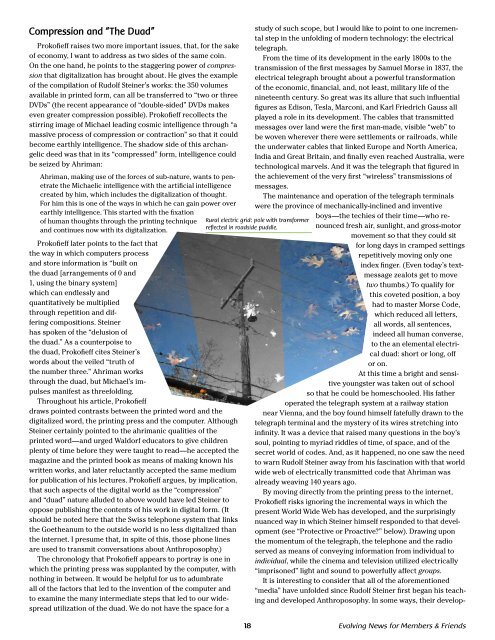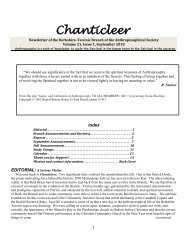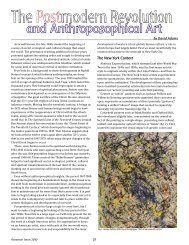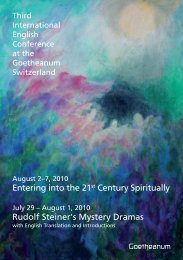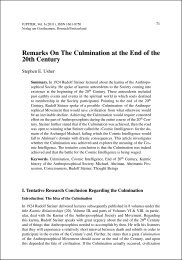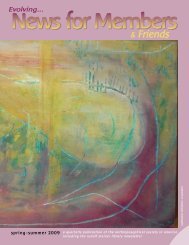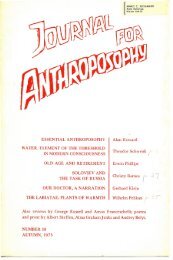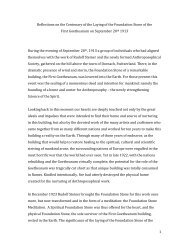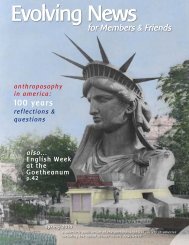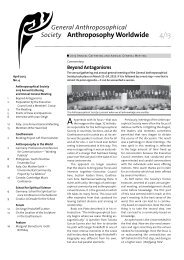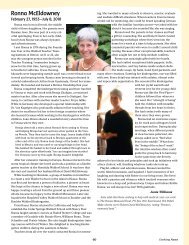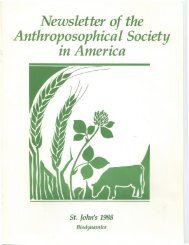& Friends - Anthroposophical Society in America
& Friends - Anthroposophical Society in America
& Friends - Anthroposophical Society in America
You also want an ePaper? Increase the reach of your titles
YUMPU automatically turns print PDFs into web optimized ePapers that Google loves.
Compression and “The Duad”Prokofieff raises two more important issues, that, for the sakeof economy, I want to address as two sides of the same co<strong>in</strong>.On the one hand, he po<strong>in</strong>ts to the stagger<strong>in</strong>g power of compressionthat digitalization has brought about. He gives the exampleof the compilation of Rudolf Ste<strong>in</strong>er’s works: the 350 volumesavailable <strong>in</strong> pr<strong>in</strong>ted form, can all be transferred to “two or threeDVDs” (the recent appearance of “double-sided” DVDs makeseven greater compression possible). Prokofieff recollects thestirr<strong>in</strong>g image of Michael lead<strong>in</strong>g cosmic <strong>in</strong>telligence through “amassive process of compression or contraction” so that it couldbecome earthly <strong>in</strong>telligence. The shadow side of this archangelicdeed was that <strong>in</strong> its “compressed” form, <strong>in</strong>telligence couldbe seized by Ahriman:Ahriman, mak<strong>in</strong>g use of the forces of sub-nature, wants to penetratethe Michaelic <strong>in</strong>telligence with the artificial <strong>in</strong>telligencecreated by him, which <strong>in</strong>cludes the digitalization of thought.For him this is one of the ways <strong>in</strong> which he can ga<strong>in</strong> power overearthly <strong>in</strong>telligence. This started with the fixationof human thoughts through the pr<strong>in</strong>t<strong>in</strong>g techniqueand cont<strong>in</strong>ues now with its digitalization.Prokofieff later po<strong>in</strong>ts to the fact thatthe way <strong>in</strong> which computers processand store <strong>in</strong>formation is “built onthe duad [arrangements of 0 and1, us<strong>in</strong>g the b<strong>in</strong>ary system]which can endlessly andquantitatively be multipliedthrough repetition and differ<strong>in</strong>gcompositions. Ste<strong>in</strong>erhas spoken of the “delusion ofthe duad.” As a counterpoise tothe duad, Prokofieff cites Ste<strong>in</strong>er’swords about the veiled “truth ofthe number three.” Ahriman worksthrough the duad, but Michael’s impulsesmanifest as threefold<strong>in</strong>g.Throughout his article, Prokofieffdraws po<strong>in</strong>ted contrasts between the pr<strong>in</strong>ted word and thedigitalized word, the pr<strong>in</strong>t<strong>in</strong>g press and the computer. AlthoughSte<strong>in</strong>er certa<strong>in</strong>ly po<strong>in</strong>ted to the ahrimanic qualities of thepr<strong>in</strong>ted word—and urged Waldorf educators to give childrenplenty of time before they were taught to read—he accepted themagaz<strong>in</strong>e and the pr<strong>in</strong>ted book as means of mak<strong>in</strong>g known hiswritten works, and later reluctantly accepted the same mediumfor publication of his lectures. Prokofieff argues, by implication,that such aspects of the digital world as the “compression”and “duad” nature alluded to above would have led Ste<strong>in</strong>er tooppose publish<strong>in</strong>g the contents of his work <strong>in</strong> digital form. (Itshould be noted here that the Swiss telephone system that l<strong>in</strong>ksthe Goetheanum to the outside world is no less digitalized thanthe <strong>in</strong>ternet. I presume that, <strong>in</strong> spite of this, those phone l<strong>in</strong>esare used to transmit conversations about Anthroposophy.)The chronology that Prokofieff appears to portray is one <strong>in</strong>which the pr<strong>in</strong>t<strong>in</strong>g press was supplanted by the computer, withnoth<strong>in</strong>g <strong>in</strong> between. It would be helpful for us to adumbrateall of the factors that led to the <strong>in</strong>vention of the computer andto exam<strong>in</strong>e the many <strong>in</strong>termediate steps that led to our widespreadutilization of the duad. We do not have the space for astudy of such scope, but I would like to po<strong>in</strong>t to one <strong>in</strong>crementalstep <strong>in</strong> the unfold<strong>in</strong>g of modern technology: the electricaltelegraph.From the time of its development <strong>in</strong> the early 1800s to thetransmission of the first messages by Samuel Morse <strong>in</strong> 1837, theelectrical telegraph brought about a powerful transformationof the economic, f<strong>in</strong>ancial, and, not least, military life of then<strong>in</strong>eteenth century. So great was its allure that such <strong>in</strong>fluentialfigures as Edison, Tesla, Marconi, and Karl Friedrich Gauss allplayed a role <strong>in</strong> its development. The cables that transmittedmessages over land were the first man-made, visible “web” tobe woven wherever there were settlements or railroads, whilethe underwater cables that l<strong>in</strong>ked Europe and North <strong>America</strong>,India and Great Brita<strong>in</strong>, and f<strong>in</strong>ally even reached Australia, weretechnological marvels. And it was the telegraph that figured <strong>in</strong>the achievement of the very first “wireless” transmissions ofmessages.The ma<strong>in</strong>tenance and operation of the telegraph term<strong>in</strong>alswere the prov<strong>in</strong>ce of mechanically-<strong>in</strong>cl<strong>in</strong>ed and <strong>in</strong>ventiveboys—the techies of their time—who renouncedfresh air, sunlight, and gross-motormovement so that they could sitfor long days <strong>in</strong> cramped sett<strong>in</strong>gsrepetitively mov<strong>in</strong>g only one<strong>in</strong>dex f<strong>in</strong>ger. (Even today’s textmessagezealots get to movetwo thumbs.) To qualify forthis coveted position, a boyhad to master Morse Code,which reduced all letters,all words, all sentences,<strong>in</strong>deed all human converse,to the an elemental electricalduad: short or long, offor on.At this time a bright and sensitiveyoungster was taken out of schoolso that he could be homeschooled. His fatheroperated the telegraph system at a railway stationnear Vienna, and the boy found himself fatefully drawn to thetelegraph term<strong>in</strong>al and the mystery of its wires stretch<strong>in</strong>g <strong>in</strong>to<strong>in</strong>f<strong>in</strong>ity. It was a device that raised many questions <strong>in</strong> the boy’ssoul, po<strong>in</strong>t<strong>in</strong>g to myriad riddles of time, of space, and of thesecret world of codes. And, as it happened, no one saw the needto warn Rudolf Ste<strong>in</strong>er away from his fasc<strong>in</strong>ation with that worldwide web of electrically transmitted code that Ahriman wasalready weav<strong>in</strong>g 140 years ago.By mov<strong>in</strong>g directly from the pr<strong>in</strong>t<strong>in</strong>g press to the <strong>in</strong>ternet,Prokofieff risks ignor<strong>in</strong>g the <strong>in</strong>cremental ways <strong>in</strong> which thepresent World Wide Web has developed, and the surpris<strong>in</strong>glynuanced way <strong>in</strong> which Ste<strong>in</strong>er himself responded to that development(see “Protective or Proactive?” below). Draw<strong>in</strong>g uponthe momentum of the telegraph, the telephone and the radioserved as means of convey<strong>in</strong>g <strong>in</strong>formation from <strong>in</strong>dividual to<strong>in</strong>dividual, while the c<strong>in</strong>ema and television utilized electrically“imprisoned” light and sound to powerfully affect groups.It is <strong>in</strong>terest<strong>in</strong>g to consider that all of the aforementioned“media” have unfolded s<strong>in</strong>ce Rudolf Ste<strong>in</strong>er first began his teach<strong>in</strong>gand developed Anthroposophy. In some ways, their develop-Rural electric grid: pole with transformerreflected <strong>in</strong> roadside puddle.18 Evolv<strong>in</strong>g News for Members & <strong>Friends</strong>


